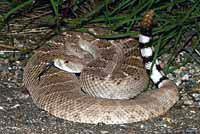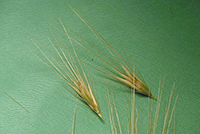Knowledge and preparation are keys to safely enjoying the great outdoors in wilderness back country. Even first responders–already familiar with the potential of encountering victims with illnesses–need to practice more than an ounce of prevention, so that they (and their K9 search companions) do not fall victim to those same hazards.
 Canine Rattlesnake Bites. The full article. Last udated June 2010. Fortunately, less than half of canine snake bites produce signs and symptoms. However, a handler cannot know whether a snake bite is dry or envenomated and should assume the worse. An envenomated rattlesnake bite is a definite canine emergency requiring appropriate veterinary care as soon as possible, to increase the chances of survival and minimize the irreversible effects that can occur. Therefore a handler should always carry the name and number for the nearest vet with antivenin and driving directions for transport to the animal hospital.
Canine Rattlesnake Bites. The full article. Last udated June 2010. Fortunately, less than half of canine snake bites produce signs and symptoms. However, a handler cannot know whether a snake bite is dry or envenomated and should assume the worse. An envenomated rattlesnake bite is a definite canine emergency requiring appropriate veterinary care as soon as possible, to increase the chances of survival and minimize the irreversible effects that can occur. Therefore a handler should always carry the name and number for the nearest vet with antivenin and driving directions for transport to the animal hospital.
 Rattlesnake Vaccination: Clarifying the Conversation. PDF document. Last udated May 2010.
Rattlesnake Vaccination: Clarifying the Conversation. PDF document. Last udated May 2010.  The rattlesnake vaccine does not, and was never intended to, eliminate the need for immediate veterinary care following a snakebite. Anecdotal evidence suggests the product helps to minimize pain, reduces swelling, and ultimately reduces tissue damage and the likelihood of death. Of particular interest to SAR handlers is that symptoms may have a more gradual onset. Some veterinarians have observed delays of about one hour, which can make a crucial diff erence when your dog is in the fi eld (far from the veterinarian’s offi ce). Furthermore, it seems that, once you reach the veterinarian, less anti -venom may be required, which would be good for both your dog and your wallet.
The rattlesnake vaccine does not, and was never intended to, eliminate the need for immediate veterinary care following a snakebite. Anecdotal evidence suggests the product helps to minimize pain, reduces swelling, and ultimately reduces tissue damage and the likelihood of death. Of particular interest to SAR handlers is that symptoms may have a more gradual onset. Some veterinarians have observed delays of about one hour, which can make a crucial diff erence when your dog is in the fi eld (far from the veterinarian’s offi ce). Furthermore, it seems that, once you reach the veterinarian, less anti -venom may be required, which would be good for both your dog and your wallet.
 Foxtails. The full article. Last updated June 2010. Foxtails pose a serious threat to dogs. The fan-shaped seeds contain small barbs,
Foxtails. The full article. Last updated June 2010. Foxtails pose a serious threat to dogs. The fan-shaped seeds contain small barbs,  which allow foxtails to become lodged in dog fur and humans’ boots or socks. Once firmly embedded in a dog’s fur, foxtails may travel under the skin, causing bleeding, infection and even death. Since the symptoms may be fairly generic in nature the presence of a foxtail problem can go unnoticed until it is severe problem. The dog should be thoroughly checked for foxtails after each field event. If a foxtail enters the dog’s skin or is suspected of being a problem, seek immediate veterinary care. Removal of the foxtail can require sedation, and medication may be necessary to prevent infection.
which allow foxtails to become lodged in dog fur and humans’ boots or socks. Once firmly embedded in a dog’s fur, foxtails may travel under the skin, causing bleeding, infection and even death. Since the symptoms may be fairly generic in nature the presence of a foxtail problem can go unnoticed until it is severe problem. The dog should be thoroughly checked for foxtails after each field event. If a foxtail enters the dog’s skin or is suspected of being a problem, seek immediate veterinary care. Removal of the foxtail can require sedation, and medication may be necessary to prevent infection.
 Common Wilderness Health Hazards. Last updated May 2010: Because of the demand that thin air places on the body, there are four illnesses that can exhibit similar signs and symptoms. It is hoped that this overview will complement the reader’s existing knowledge and promote prevention through diet and exercise. In addition to watching for signs in themselves and others, the K9 handler be completely familiar with the dog’s energy level and disposition, in order to “read” any signs or symptoms of a potential medical issue. Knowledge of the dog’s daily physical routine determines the level of physical exertion that can be safely expected in the field. Learn how to recognize the illnesses and their symptoms, treatment and prevention. List of references cited.
Common Wilderness Health Hazards. Last updated May 2010: Because of the demand that thin air places on the body, there are four illnesses that can exhibit similar signs and symptoms. It is hoped that this overview will complement the reader’s existing knowledge and promote prevention through diet and exercise. In addition to watching for signs in themselves and others, the K9 handler be completely familiar with the dog’s energy level and disposition, in order to “read” any signs or symptoms of a potential medical issue. Knowledge of the dog’s daily physical routine determines the level of physical exertion that can be safely expected in the field. Learn how to recognize the illnesses and their symptoms, treatment and prevention. List of references cited.
 High altitude illnesses
High altitude illnesses
 Hypoglycemia (low blood sugar)
Hypoglycemia (low blood sugar)
 Exercise-induced asthma
Exercise-induced asthma
 Hyperthermia (heat illness).
Hyperthermia (heat illness).
 Wildnerness First Aid Kit Supplies. List of first aid supplies to consider for your first aid kit. Last updated May 2010.
Wildnerness First Aid Kit Supplies. List of first aid supplies to consider for your first aid kit. Last updated May 2010.